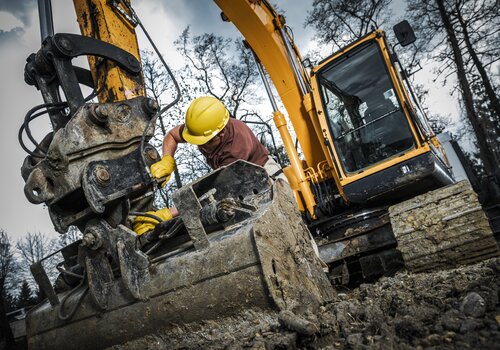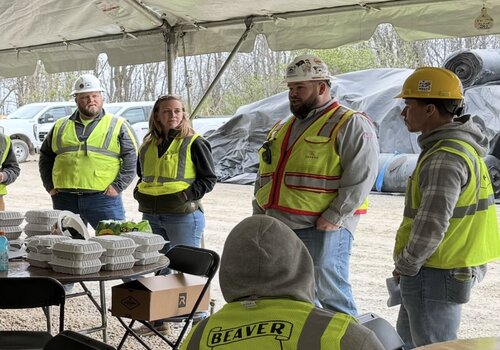The construction industry is undergoing a transformation, driven by technological advancements, sustainability goals and evolving market demands. For construction workers and business owners alike, staying ahead of these trends is crucial to remain competitive and efficient. Here are some of the most impactful international construction trends shaping the industry today.
1. GREEN BUILDING AND SUSTAINABILITY
Green building practices are being adopted worldwide to reduce environmental impact and meet regulatory requirements. From using eco-friendly materials to integrating energy-efficient technologies, construction companies are prioritizing projects that minimize carbon footprints.
For example, green buildings often incorporate renewable energy sources like solar panels and use non-toxic, sustainable materials. These practices not only benefit the environment but also improve the health and safety of building occupants. As clients increasingly demand environmentally responsible projects, adopting green construction methods is becoming a strategic business imperative.
Countries like Sweden and Germany are at the forefront, with initiatives such as energy-efficient buildings and the use of renewable materials. For example, Germany’s Passive House standards are globally recognized for their focus on energy efficiency.
2. DIGITAL TRANSFORMATION
The digital revolution is reshaping how construction projects are designed, managed and executed. Tools like Building Information Modeling (BIM) and Construction Management Software (CMS) are becoming industry staples. BIM allows teams to create detailed virtual models of structures, reducing errors and improving collaboration. Meanwhile, CMS streamlines project management, helping teams stay on schedule and within budget.
Virtual and augmented reality are also making waves. These technologies enable stakeholders to visualize projects before they’re built, enhancing decision-making and reducing costly reworks. As digital tools become more accessible, even smaller firms are leveraging them to improve efficiency and competitiveness.
Singapore is a leader in adopting BIM technology, mandating its use for public sector projects.
3. PREFABRICATION AND MODULAR CONSTRUCTION
By assembling components off-site in controlled environments, prefabrication and modular construction reduce waste, improve quality and speed up project timelines. Modular construction, in particular, is gaining traction for its ability to deliver high-quality structures quickly and cost-effectively.
This trend is especially prominent in urban areas where space and time are at a premium. From residential buildings to hospitals, modular construction is proving to be a versatile and sustainable solution.
China is a global leader in modular construction, with projects like the 57-story Mini Sky City, built in just 19 days. The United Kingdom is also embracing this trend, particularly in urban housing projects where speed and efficiency are critical.
4. SMART CITIES AND IOT INTEGRATION
The rise of smart cities is influencing construction practices globally. Internet of Things (IoT) devices are being integrated into buildings to enhance functionality and efficiency. Smart sensors can monitor energy usage, detect maintenance needs and even improve safety by identifying potential hazards.
For construction businesses, this means an increased focus on designing and building structures that are compatible with smart technologies. As urban areas continue to grow, the demand for smart, connected buildings is expected to rise.
South Korea is a pioneer in this area, with smart city projects, which integrate IoT devices for energy management and safety. The Netherlands is also making strides, incorporating smart technologies into urban planning and building design.
5. AUTOMATION AND ROBOTICS
Automation is addressing some of the construction industry’s biggest challenges, including labor shortages and productivity gaps. Robots are being used for tasks like bricklaying, concrete pouring and even demolition. These machines not only improve efficiency but also enhance safety by taking on high-risk tasks.
Drones are another game-changer. They’re being used for site surveys, progress monitoring and even material delivery. By automating repetitive and dangerous tasks, construction companies can focus their human workforce on more complex and creative aspects of projects.
Japan is leading the way with construction robots that perform tasks like bricklaying and concrete pouring. Drones, widely used in Australia, are transforming site surveys and progress monitoring.
6. 3D PRINTING
3D printing is no longer a futuristic concept; it’s a reality in the construction industry. This technology allows for the creation of complex structures with minimal waste and reduced labor costs. From printing entire homes to producing custom components, 3D printing is pushing the boundaries of what’s possible in construction.
Countries like the Netherlands and the UAE are leading the way, with projects ranging from 3D-printed bridges to office buildings. As the technology becomes more affordable, its adoption is expected to grow across the globe.
7. FOCUS ON WORKFORCE DEVELOPMENT
Workforce development is becoming a priority, with companies investing in training programs to upskill their employees to keep up with industry evolution. From learning to operate advanced machinery to mastering digital tools, construction workers are being equipped to meet the demands of modern projects.
Additionally, initiatives to attract younger talent to the industry are gaining momentum. By showcasing the innovative and impactful nature of construction work, companies hope to address labor shortages and build a skilled workforce for the future.
Canada is investing heavily in workforce development, offering training programs to upskill workers in digital tools and advanced machinery. Germany is also known for its robust apprenticeship programs, which prepare workers for the demands of modern construction.
8. RESILIENCE AND ADAPTABILITY
The construction industry has faced its share of challenges, from supply chain disruptions to climate-related risks. Resilience and adaptability have become key themes, with companies adopting strategies to mitigate risks and ensure project continuity. New Zealand is focusing on resilience by designing buildings to withstand earthquakes.
For example, sourcing materials locally can reduce dependency on global supply chains, while designing buildings to withstand extreme weather events can enhance their longevity. By prioritizing resilience, construction businesses can navigate uncertainties and thrive in a changing landscape.
The construction industry is at a crossroads, with innovation and sustainability driving its evolution. For construction workers and business owners, embracing these trends is not just about staying relevant—it’s about shaping the future of the industry. Whether it’s adopting green building practices, leveraging digital tools or investing in workforce development, the opportunities are endless.
By staying informed and proactive, you can position yourself and your business for success in this dynamic and exciting field. After all, the future of construction is being built today.
Photo credit: METAMORWORKS/SHUTTERSTOCK.COM












